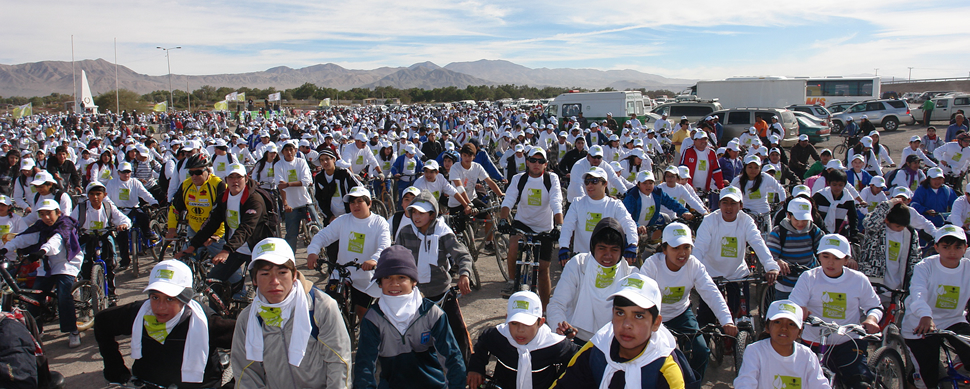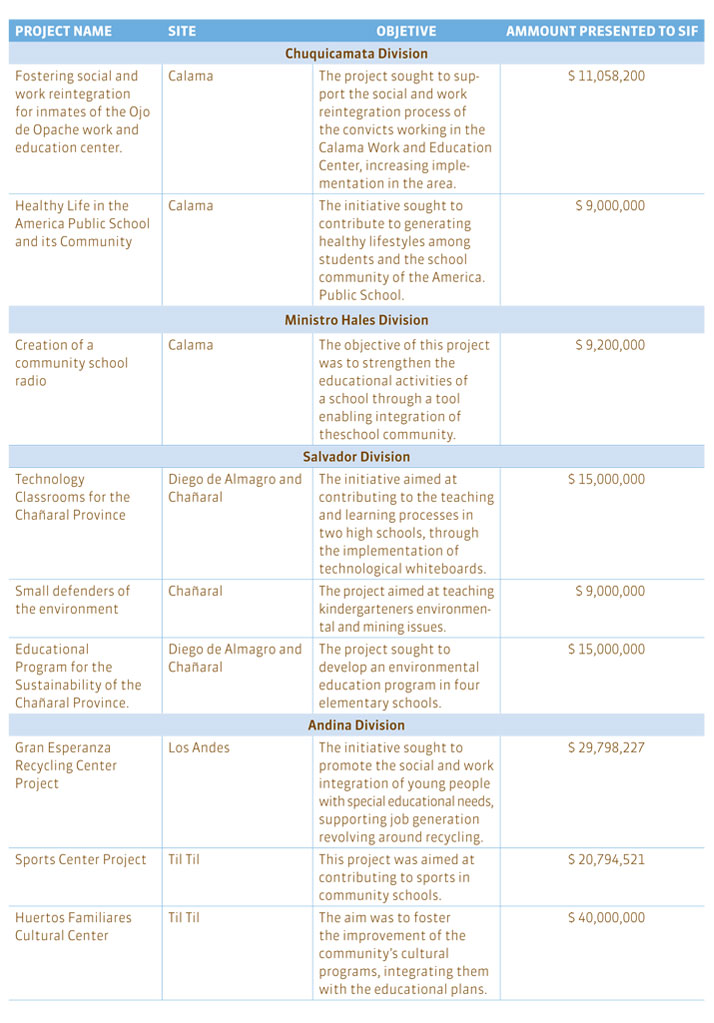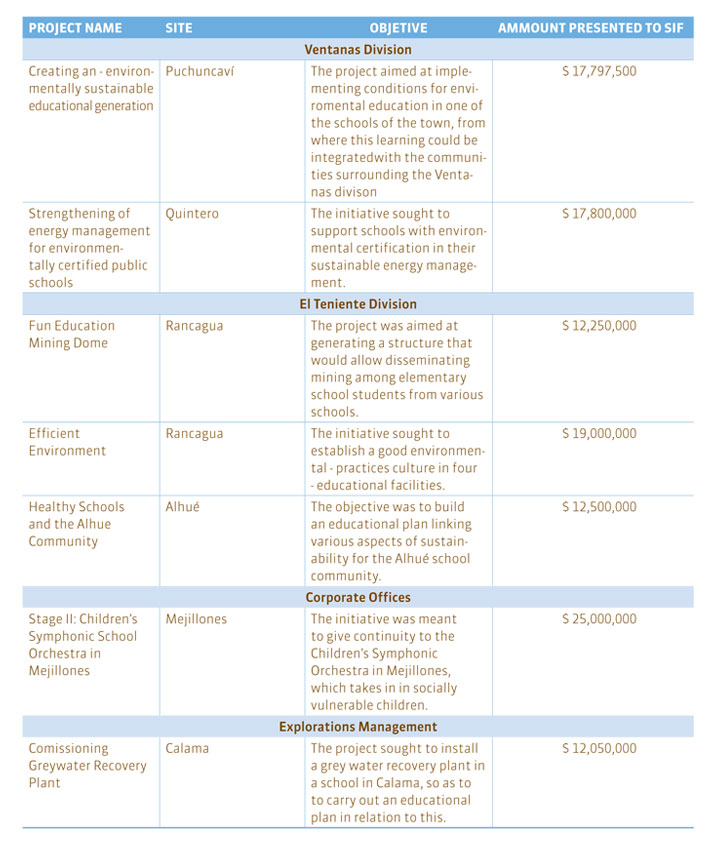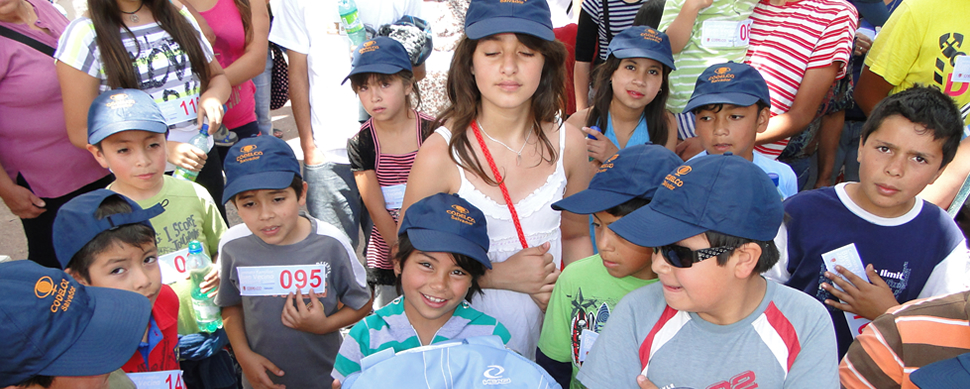From community management to community development
Community development is the process of strengthening the communities, improving the quality of life of the population, and allowing their participation in decision-making, in order to increase their control over their lives in the long term. This definition, in line with what is indicated by the ICMM, is consistent with Codelco’s progress in managing its surrounding communities, and also responds to the procedures that frame our actions, such as the Value Statement and the Code of Business Conduct and Ethics, which has been adopted by the Corporation. In general terms, Codelco has gone from focusing on community relationship and management to an axis centered on community development, whose goal is to effectively contribute to the improvement of living conditions in the communities, as is expressed in the Sustainable Development Policy of 2003.
COMMUNITY STANDARDS
From the above definition, and within the framework of the Structural Project for the Environment and Communities, during 2011 we worked on developing standards that would enable us to commit to the development and to building relationships with our surrounding communities. This was reflected in two standards prepared in conjunction with the divisional community development teams between the months of July and September, after a global benchmark on industry procedures, along with the experience accumulated through working with the community.
Among other information, the standards were based on the proposals by the ICMM and IFC on local development, community participation and the strengthening of their capacities and resources, elements that are in turn considered by large mining companies.
The Corporation defined a Community Development Standard that aims to contribute to the development of the communities by being an active partner, strengthening their capabilities and resources to improve their quality of life in the long term; and a Community Relations Standard, which seeks to build reliable, transparent, and long-term relationships with the community, based on a logic of collaboration and mutual benefit, which allows knowing their opinion on Corporate decisions that affect their development and living conditions.
After developing these standards, it is necessary to develop procedures and generate the internal capacity required for its full implementation. The Corporation will work on this during 2012.

CENTER FOR SOCIAL RESPONSABILITY IN MINING (CSRM)
During 2011, as additional background to the development process for the Standards, the Corporation, with the help of the CSRM of the University of Queensland, began a detailed review of the community management activities carried out by Codelco.
The Center is a leader in research on the subject, and is committed to improving the social performance of the resources industry worldwide. With the support of the University of Queensland, the Center works with various organizations and companies around the world, in research projects, services, education and training, with the aim of supporting social processes linked to resource extraction and local development.
The review plan began with a socioeconomic diagnosis of the communities in each division’s area of influence, along with a map of socio-economic effects and historical liabilities. At the same time, each of the policies, procedures, tools, and studies the Corporation has in this matter were reviewed. The Center met with company staff, and a joint corporate workshop was organized. Currently, the Center is reviewing all background information in order to deliver, during 2012, a complete diagnosis and a work plan that will allow Codelco to move towards global leadership in this area.
TRAINING OF OUR PROFESSIONALS
As part of the Corporation’s job training plan, during 2011 community development professionals from each of the divisions, explorations and Corporate Offices attended a workshop-course taught by the NGO Center for Social Response (CSR)1, of OXFAM2.
The course is the first in a three-part series that form part of a comprehensive training program. Its objective is to teach a people-centered approach as a tool for dialogue and community development. The course, carried out during the month of July in Santiago, was attended by 20 people.
1 Non-Governmental Organization, who acts mainly in Africa, it has dedicated itself to training companies so that their actions with the community will have an impact on local development.
2 Confederation of organizations that brings together 15 NGOS in 90 countries around the world, whose objective is to form alliances to defeat poverty.
SOCIAL IMPACT MANAGEMENT
(EC9/SO9)
EC9 Understanding and describing significant indirect economic impacts, including the extent
of said impacts.
SO9 Operations with significant actual or potential negative impacts on the communities.
In the 2010 Sustainability Report we informed of our work
on a procedure for the identification and evaluation of Community
aspects, whose goal was to evaluate the effects of all
operations and projects actions on different social dimensions,
considering the territorial, environmental, demographic, sociocultural,
social well-being, socioeconomic, indigenous peoples
and human rights dimensions. In October 2011, we presented our
tool within the framework of the International Seminar on Social
Responsibility in Mining, held in Santiago and organized by Gecamin.
It was positively assessed by a public who is mainly linked to
community management for mining companies.
LOCAL DEVELOPMENT
(EC9/SO10)
EC9 Understanding and describing significant indirect economic impacts, including the extent
of said impacts.
SO10 Preventive and mitigating actions implemented in operations with significant actual or
potential negative impacts on the communities.
Within the framework of contributing to local development,
each of our divisions continued its Codelco Good Neighbor
Program, developing various social projects in each of the
localities in the area of influence, thus adding to our operations’
mitigation and impacts compensation. The Social Investment
Fund (SIF), funds that allows joint project co-financing between
divisions, social organizations, and the corporate center, carried
out the following initiatives during 2011:


DEVELOPMENT AND IMPACT OF INFRASTRUCTURE PROJECTS
(EC8) Development and impact of infrastructure investments and services provided, primarily for public benefit through commercial, pro bono, or in kind engagement. The Corporation has continued to develop projects focused on improving the infrastructure of the communities surrounding their operations, as a specific action that seeks to improve the quality of life of their inhabitants. Among the major projects driven by some divisions in this line are:
Chuquicamata Division
Collaborated in various initiatives for the improvement of public roads in the Calama road system, mainly through applying roads with a layer of bischofite. It also supported the construction of infrastructure for the Atacama community of Lasana, facilitating the enabling of recreational spaces for social integration and the community’s enjoyment. The foregoing meant the division invested approximately $ 273,000,000.
El Teniente Divisione
Continued promoting the development of infrastructure projects that are of direct benefit to the neighbors in the proximity of its tailings dam operation. This is how the sectors of Santa Maria de Loncha, Hijuelas de Pincha and Quilamuta received 40 solar thermal systems for heating domestic water, so as to contribute to the improvement of social and environmental conditions in these rural areas. This investment reached a sum of $ 43,414,120.
INDIGENOUS PEOPLE
Mining coexists with various communities, among which we highlight indigenous people, who have a close link to the territory, deep roots with the land, and long-established cultures that have persisted through time. The issue of indigenous rights, in addition, has taken on greater relevance at a national and international level. In Chile, the enforcement of Agreement 169 of the International Labor Organization (ILO) has started a process of institutionalizing the matter in different areas, and at a global level, mining itself has been catching up with its own procedures.
Codelco, recognizing this fact, worked during 2011 to update and redesign its Commitments with Indigenous Peoples in terms of a standard that takes concepts from global mining, especially through the ICMM and IFC, national legislation, and ILO convention 169.
The Indigenous Peoples Standard aims to contribute to the development of indigenous peoples, recognizing their particularitiesand widely respecting their interests, manner of organization, customs, and ways of life.
(MM5) Total number of operations taking place in or adjacent to Indigenous Peoples’ territories, and number and percentage of operations or sites where there are formal agreements with Indigenous Peoples’ communities. The divisions linked to indigenous peoples and located in the II Region of Antofagasta are Chuquicamata, Radomiro Tomic, and Ministro Hales and, in the III Region of Atacama, the Salvador Division, which is linked to the Atacameño, Quechua, and Colla communities. Some examples of projects in divisions with indigenous people are:
Lasana Museum: Project by the Chuquicamata Division, whose objective was the development and construction of a facility dedicated to the rescue, maintenance and exhibition of the natural and cultural heritage present in the Atacama desert (Licanantay culture).
![]()
(2.10)
Awards received in the reporting period
El The Lasana Museum project was
awarded the Best CSR Practice in
Latin America by the Mexican Center of
Philantropy (CEMEFI) and Forum Empresa,
in the category “connecting with
the community”.
Cooperation Agreement with the Quechua Community in San Pedro Station: Project by the Radomiro Tomic division, whose purpose is to stimulate the resettlement of the community in the village, with initiatives that aim at improving agricultural soils, building irrigation canals and improving the town.
Cooperation Agreement with Municipality of San Pedro de Atacama: Project by the Chuquicamata Division, which enables economically supporting physical therapy in special needs children of the Ayllu people in San Pedro de Atacama. The beneficiary group is called JURIKE.
Project with the Colla community in Diego de Almagro: The Salvador Division permanently supports the Colla community in Diego de Almagro. During 2011, work was carried out to supply water for the drinking water system installed in the rural Quebrada de Agua Dulce. Similarly, the transportation of members of the community for the implementation of a project called “Earth’s Essence in the Hands of Women”, within the framework of the Special Program for Health and Indigenous Peoples, was supported as well.

ARTISANAL AND SMALL-SCALE MINING
(MM8) Number and percentage of company operating sites where artisanal and small-scale mining (ASM) takes place on, or adjacent to, the site; the associated risks and the actions taken to manage and mitigate these risks. Codelco has always collaborated with small scale mining, as is the case in the surroundings of the Chuquicamata and Salvador divisions, where small mining groups are present. We give them our support to reduce health and safety risks for their workers, and reduce the possible negative impacts to the environment that could occur when there are low operation standards:
- In the Chuquicamata Division we have small scale mining activities carried out by a Quechua indigenous association, associated with the removal of ulexite from the Ascotán Salt Flat. The division permanently monitors these activities to avoid environmental and safety risks, and since 2010 a transfer of these mineral rights to the National Mining Company (Enami) has been taking place.
- In the vicinity of the Salvador Division, in the Inca de Oro locality, small scale miners carry out mining activities. The division monitors these activities with the commitment of cooperating with the safety of these associations, transferring to them, in 2011, tools as well as security and emergency implements.
Furthermore, in the Ventanas Division we maintain relationships with small and medium-sized mining groups through the purchase of minerals with a high concentration of copper, gold and silver, ensuring the ability to melt and refine, with no restrictions or limitations, the copper production of these providers.
CALAMA PLUS PLAN
The Calama Sustainable Urban Plan or Calama PLUS, seeks to build and agree on a sustainable urban development program for the city of Calama, based on the cooperation and participation of the inhabitants, authorities, Codelco, and the major companies operating in the city.
The plan is born of an agreement between the Municipality of Calama, the Government of the II Region of Antofagasta and companies in the area, in which they undertook to develop a common and comprehensive vision of the city and design emblematic projects which will contribute to improving the quality of life of the inhabitants of the capital of the Loa Province.
The first stage is focused on the design of a master plan for the city, identifying the priorities and projects, which, realistically speaking, can be developed in the city, based on three fundamental axis:
- conserving the oasis and extending its conditions to the rest of the city,
- developing superior-quality urban areas, and
- promoting initiatives that strengthen the human and social capital.
![]()
The Calama Plus Plan has developed a
broad and deep participation process
with the whole community, establishing
a permanent dialogue with various
social organizations for its collective
development. We have carried out open
citizen forums and a series of thematic
forums focused on project co-production,
along with other tools and initiatives
both on-site –such as the installation
of a permanent open house– and
digital, among others.
LA GREDA CASE: LOOKING TOWARDS THE FUTURE
(MM6) The Number and description of significant disputes relating to land use, customary rights of local communities and Indigenous Peoples. For Codelco, a community conflict is one that puts operations and new projects at risk, as well as that which negatively affects the company’s reputation. From this definition, the Corporation faced a conflict with the communities surrounding the Ventanas Division, located in the V Region of Valparaiso, in the wake of the episode in La Greda on March 23rd
The environmental event of March 23rd, 2011 in the locality of La Greda marked a key moment in the relationship between the company and the neighbors of the Ventanas Division.
From the beginning, the Ventanas Division decided to act with complete transparency towards the community, public services and regulatory authorities, and then take action, forming 10 discussion tables with the La Greda neighbors, where the main problems affecting them and how to collaborate to solve the needs of the community were discussed.
After conversations, Codelco’s Ventanas Division began developing a series of initiatives that would directly benefit the neighbors, such as Grant Resources and Social Investment Funds, whose recipients were precisely inhabitants of La Greda.
Along with this, our concern was focused on the children of the La Greda School, which is why the company decided to donate 1,000 million pesos for the construction of a new school campus, located in the Campiche sector. The new school will have modern educational and sports facilities.
In addition, we have developed an important investment plan aimed at mitigating the impacts of our operations in the area.
All these actions and projects seek to make our company’s operation develop with respect for the environment and our relationship with the community.
![]()
We actively participate in the Clean
Production Agreement, sponsored
by the Ministry of Environment, the
National Council for Clean Production,
and 10 public and private companies of
the Puchuncaví-Quintero industrial area,
to run individual and collective actions
for the mitigation of environmental
impacts.